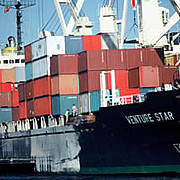Vessels of all sizes and for all purposes can significantly contribute to the introduction of exotic, non-native species:
- Boats offer a remarkable set of opportunities for effectively transferring exotic species. Marine organisms (both plant and animal) can be transported through hull fouling, on anchors and anchor chains, in keel center cases (which can contain fish), on transducers, knot meters, rudders, propeller shafts, keels, and so forth. However, the number one carrier of Marine Invasive Species in terms of volume is ballast water: large quantities of water are taken up in one port after ships unload cargo, and then discharged at the next port where cargo is loaded. A number of sailing vessels, including the most modern yachts, can also carry ballast water.
- Vessels that have longer port residencies may have a greater potential to introduce species because of the increased opportunity for reproduction of organisms and their dislodgement off the hull.
- Large international boats gatherings can import species from novel areas around the world - from regions strikingly different than the normal ship arrival and trade patterns that hosting harbour experiences.
- Sailing vessels cross the seas at 5-10 knots, as compared to large commercial vessels that often exceed speeds of 20 knots. Slower vessels thus have the potential to be more effective carriers of exotic species that do not get washed away at higher speeds.
One could argue that “everything that could be introduced has been introduced by now”. However, new ship-mediated invasions still occur regularly around the world; vessels are faster and species may survive voyages better, harbor environments change and can be more susceptible to invasions, trade patterns evolve, and so on. These new invasions can have spectacular environmental and ecological impacts.






